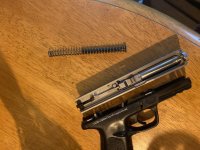Galloway offers 15, 17, 20, and 22 pound recoil assemblies, but no 18 pound. On their site, they say the 17 pound is the stock spring weight. I could swear that S&W told me before that it was 18 pounds. I'm going to call them and see if I can confirm that but I was wondering if anyone here had already confirmed that with S&W.
Also, I was wondering if anyone here had tried both the 17 lb and the 20 lb Galloway recoil assemblies in their SD9VE, and what the results were.
Thanks.
Also, I was wondering if anyone here had tried both the 17 lb and the 20 lb Galloway recoil assemblies in their SD9VE, and what the results were.
Thanks.

